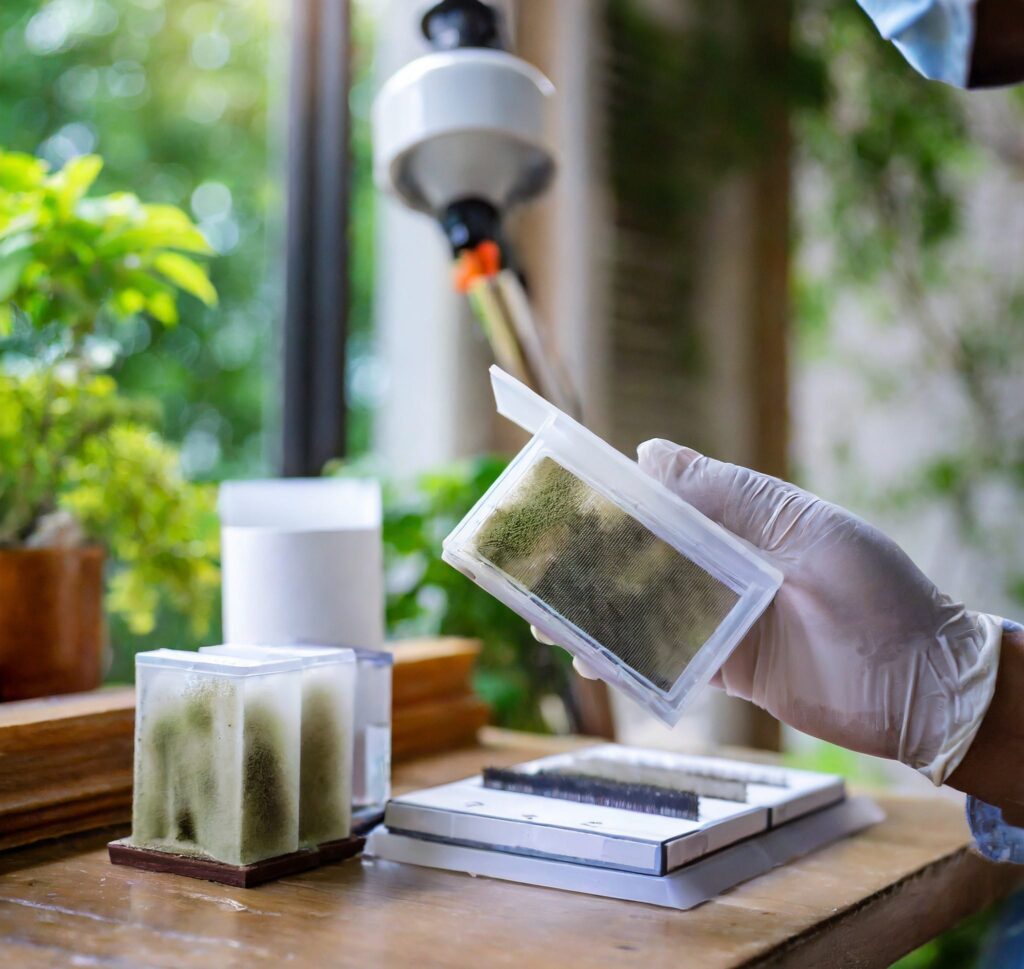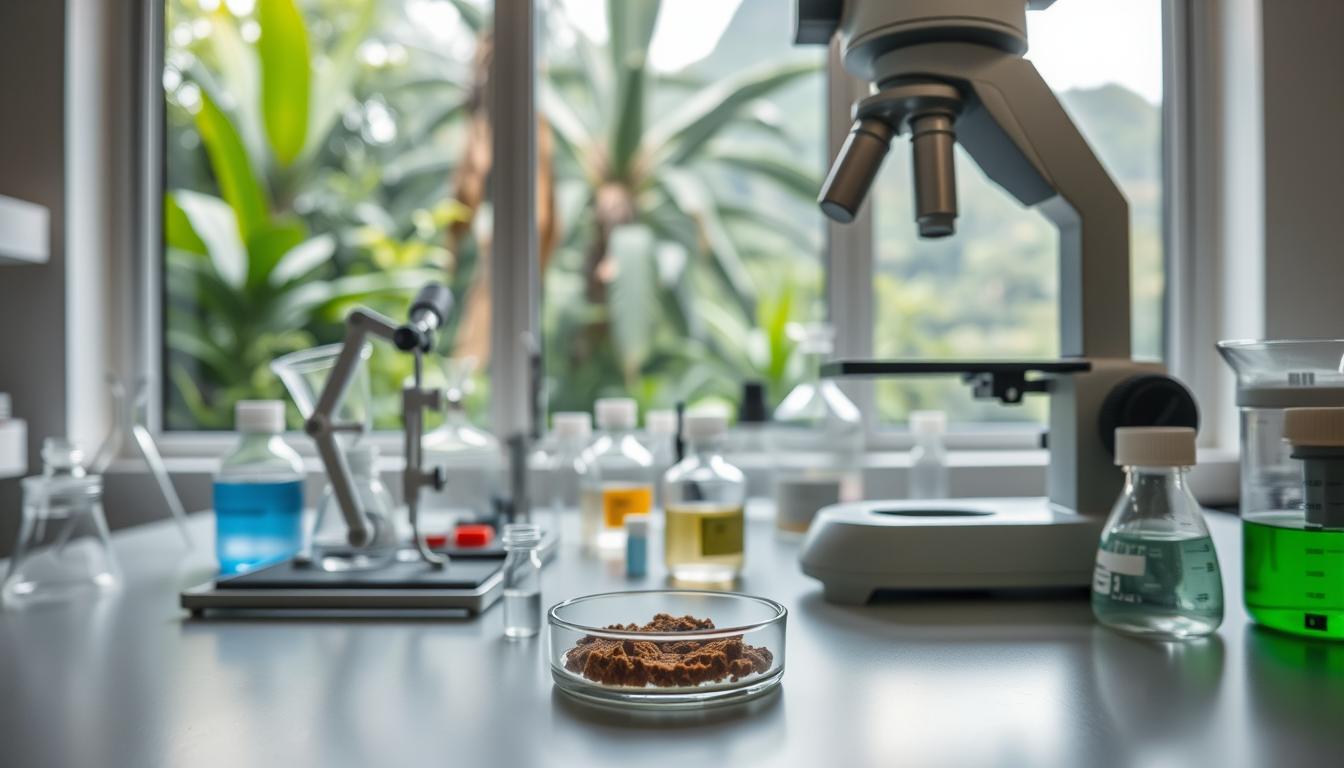Mould sample testing is key to keeping health and property safe. Hidden mould can lead to allergies, asthma, and damage buildings. In Cairns, the warm and humid weather makes it perfect for mould growth.Regular testing catches small problems before they get big. It finds out what kind of mould is there and how much. This helps keep everyone safe before damage gets worse.
Key Takeaways
- Mould sample testing reveals hidden mould growth in homes and businesses.
- In Cairns’ tropical climate, mould spreads rapidly without regular testing.
- Testing identifies mould species and contamination levels to guide safe remediation.
- Early detection through mould sample testing prevents costly repairs and health risks.
- Professional testing ensures accuracy, avoiding DIY methods’ limitations.
Understanding the Hidden Dangers of Mould in Australian Homes
Mould in Australian homes often hides until it affects health or property. In Cairns, the tropical climate makes mould a big threat. Testing for mould in Cairns and sampling are key to catch these dangers early. This section looks at common mould types in tropical areas, their health risks, and why Cairns needs proactive measures.
Common Types of Household Mould in Tropical Climates
Several mould species do well in Cairns’ warm, humid weather. These include:
- Aspergillus: Found on walls and insulation, causing respiratory irritation.
- Penicillium: Often in carpets and basements, linked to allergies.
- Stachybotrys (Black Mould): Grows on wood and damp areas, producing toxins harmful to the nervous system.
Health Risks Associated with Mould Exposure
Exposure can cause symptoms from sneezing to asthma attacks. Kids and those with weak immune systems are at higher risk. Severe cases may lead to neurological problems, showing the need for professional mould sampling in Cairns to prevent long-term harm.
How Cairns’ Climate Creates Ideal Conditions for Mould Growth
Cairns’ climate has high humidity, heavy rainfall, and warmth all year. These conditions let mould spread fast in homes. Moisture from storms and poor ventilation create perfect breeding grounds. Regular mould testing in Cairns helps find infestations before they spread.
What is Mould Sample Testing and Why It Matters
Mould sample testing checks for mould spores or growth. It finds out what kind, how much, and the risks. This is key in Cairns, where high humidity and tropical weather make mould grow fast. Knowing how to test helps get accurate results for the right actions.
Different Methods of Collecting Mould Samples
There are different ways to collect mould samples:
- Air sampling: Uses spore traps to catch airborne mould spores, great for finding hidden growth.
- Surface sampling: Swabs or tape lifts take mould from surfaces like walls or furniture.
- Bulk sampling: Removes small material samples (like drywall) for lab tests.
- Dust sampling: Checks dust particles to see if there’s been mould exposure before.
When Professional Testing is Necessary vs. DIY Options
DIY kits can do basic checks but aren’t precise. Professional mould testing is needed in these situations:
- Visible mould colonies bigger than 1m²
- People have allergy-like symptoms
- After floods or water damage
DIY kits are good for first checks but can’t tell you the exact type or amount of mould.
Benefits of Early Detection Through Testing
Testing early saves money and health risks. In Cairns, acting fast can cut down remediation costs by up to 60%. Regular testing also:
- Stops timber-framed homes from decaying
- Reduces asthma triggers for families
- Keeps property value up
In Cairns’ humid climate, testing early keeps living spaces safe and healthy.
Signs That Indicate You Need Mould Sample Testing
- Physical Clues: Spots of black, green, or white discoloration on walls, ceilings, or under sinks. Peeling paint, warped floorboards, or bulging drywall indicate moisture buildup. Water stains near windows or roofs often point to leaks.
- Sensory Cues: A lingering damp smell, even if no mould is visible, signals microbial growth. Sneezing, itchy eyes, or coughing that eases when leaving the property may stem from mould exposure.
- Environmental Triggers: Recent flooding, plumbing leaks, or storm damage creates ideal mould conditions. Renovations exposing old walls or moving into a newly purchased home should prompt testing. Post-wet season checks are vital in Cairns.
Ignoring these signs risks health and property damage. Professional mould analysis confirms whether visible spots are harmless or hazardous. For example, a Cairns home with minor water stains might hide extensive growth behind walls. Only certified testing reveals species and severity, guiding safe remediation. Delaying action can worsen health risks and repair costs.
The Professional Mould Testing Process in Cairns
In Cairns, mould testing is done both in the field and in labs. It helps find mould in hidden spots or check if it’s gone after cleaning. Every step is followed carefully to get accurate results in the tropical weather.
How Samples Are Collected and Transported
Technicians in Cairns look for mould in places like bathrooms and basements. They use clean tools to take air, surface, or bulk samples. This captures spores and visible mould.
To keep samples safe, they:
- Use special equipment like air pumps or swabs
- Keep samples separate to avoid contamination
- Take notes on humidity and temperature
Then, they quickly send the samples to a lab in Cairns. This is important because of the warm, humid weather.
What Happens in a Cairns Mould Laboratory
In certified labs in Cairns, samples are tested in three ways. They culture to find active mould, use microscopes for detailed looks, and do DNA tests for specific types. Labs follow strict standards to ensure accurate results.
They can tell the difference between harmless spores and harmful ones like Stachybotrys. This is important in Cairns’ climate.
Timeline for Results and Next Steps
Results usually come in 3–7 business days. The time it takes depends on:
- How busy the lab is
- The type of test needed (DNA tests take longer)
- How complex the case is
After getting the results, clients get a detailed report. It shows what types of mould are present, how much, and the health risks. Many labs offer free consultations to talk about the results and suggest how to fix the problem.
Interpreting Your Mould Test Results
Understanding your mould test results cairns starts with decoding the data. Lab reports often include spore counts, species names, and comparisons to local baselines. A professional mould analysis provides context, explaining whether levels exceed Cairns’ typical tropical environmental standards.
- Spore counts: Compare indoor readings to outdoor baselines. Levels above 1,000 spores/m³ may signal contamination.
- Species matter: Aspergillus or Stachybotrys (toxic black mould) require immediate attention.
- Climate context: Cairns’ humidity means baseline thresholds differ from drier regions—ask experts for local benchmarks.
Health Implications of Your Results
Elevated levels of Cladosporium or Penicillium may worsen asthma. If results show high allergenic mould, consult a doctor, especially if household members have respiratory issues. Persistent coughing or skin irritation after exposure could correlate with test findings.
When Remediation is Needed
- Thresholds: Remediate if spore counts exceed 2,500/m³ or toxic species are detected.
- Location matters: Mould in HVAC systems or living areas demands urgent action.
- Sensitivity factors: Homes with infants or elderly residents require lower intervention thresholds.
Always discuss results with licensed mould specialists. Avoid DIY fixes for severe contamination—professional remediation ensures safe removal and prevents recurrence in Cairns’ humid environment.
Conclusion:
Your home mould test Cairns results are key to keeping your family safe and your home in good shape. If the test shows no mould, just a little, or a lot, you need to act differently. For no mould, fix leaks, improve air flow, and watch areas like bathrooms closely.
Testing every 1–2 years is important in Cairns’ wet climate to find problems early.
If you find a small mould spot, you might be able to clean it yourself with EPA-approved cleaners. But, you must fix the cause, like damp walls or bad air flow. Big mould problems need a pro. Look for certified mould cleaners in Cairns who know how to safely remove mould and stop it from coming back.
Don’t ignore mould or bad smells. It can make health problems worse and damage your home.
Mould testing Cairns isn’t a one-time thing. If your home has had mould before, if people in your home have allergies, or if your home is near water, test every six months. Focus on fixing problems for good, not just quick fixes. Seal up cracks, use dehumidifiers, and make sure water drains away properly. Taking these steps makes managing mould a regular part of home care, keeping your home safe for years.



